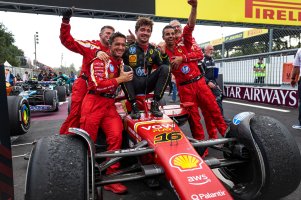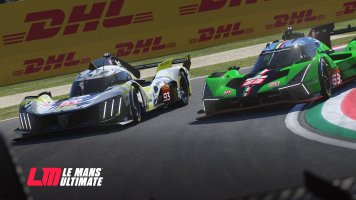After an exciting Italian Grand Prix, OverTake editor Angus has come to the conclusion that its result shows a sad truth about the sport, a truth sim racing can overcome. Here is what he means.
If you do not get emotional at a Ferrari win at home in front of the Tifosi, are you a real Formula One fan?
Well, last weekend finally made it happen as for the first time since 2019, a sea of red invaded the Monza start-finish straight following the first place arrival of Charles Leclerc aboard his scarlet Ferrari in the 2024 Italian Grand Prix.
A daring overtake by Oscar Piastri around the outside of McLaren teammate Lando Norris set the early tone of what would be a hard-fought GP. But it is not the result that upset me as, as the first sentence shows, watching the Tifosi celebrate a second win of the season for car 16 brought tingles to my spine. What upset me however is the way in which the result came about.
For the first half of the race, with an out-of-position Norris, race pace appeared to be nearing race speed record potential as the entire field attempted to better their positions. But by the halfway point, a strategic decision lead to a sudden drop in lap times. As the McLaren pairing pitted for a second time, Ferrari's duo decided to stay out in a bid to cut a stop from their strategy.
For the remaining 20-odd laps, both Oscar Piastri and Lando Norris would have to catch the time up in the hopes of closing the gap to Carlos Sainz and eventual winner, Leclerc and pass them. Teeing up quite the eventful situation, the slower-running Ferrari of Leclerc managed to keep ahead of McLaren's boys.
There is no denying that this made for an exciting Grand Prix with many fans no-doubt biting their nails away up until the chequered flag. But following the event, all it proves is that Formula One's tyres consistently encourages teams to opt for slower strategies rather than pushing the boat out.
Though unlike previous eras in which running a set beyond its life span would result in a sudden loss of pace, otherwise known as the cliff, or an outright tyre failure, modern rubber simply experiences a gradual lap time loss. Grip may disappear, but it is far from a quick process, with failure or a full loss of grip seemingly never coming.

Mercedes and Red Bull fight for the lower points in Monza. Image: Mercedes-AMG Petronas F1 on Lulop
It is because of this fact that Formula One's apparent motto nowadays goes along the lines of the winner is the driver spending the least time in the pits. As such, most Grand Prix see teams and drivers coast around a track for an hour and a half in fear of over pushing the tyre. Single-file driving, little strategic variance and lap times a good half-dozen seconds off the ultimate pace is typically the formula to a modern Grand Prix.
With as few pitstops as possible and drivers all seemingly pitting on near-enough the same lap, gone are the days of reckless strategies seeing up to five stops per race, varying tyre life and hard-fought overtakes. To me, that feels like a sad prospect.
Sure, the best of the best flying their way through iRacing's top split Special Events will take the time to think about their tyres. But mere mortals like you or I seldom worry about such pitiful issues. In fact, the longest races many of us run may hit the hour-mark. But at a single stint in most sportscars, that is rarely enough to trouble a set.

Tyre wear in sim racing doesn't appear to be as determining as in real life. Image: Reiza Studios
Moreover, the true tyre killer in the real world is dirty air, something I feel is never perfectly simulated in-game. Sure, some titles may see reduced grip when following cars closely. But that loss of grip is rarely particularly troublesome, nor does it spread to multiple seconds behind a leading car.
The result are races in which one can push to the edge of grip, and often times beyond it, in the pursuit of that next position. Indeed, requiring players to hold back for several laps to keep tyre temperatures in-check and perfectly executing a pass before your tyres do fall off the cliff would be a horrendous feature to simulate, even in the most realistic of sims.
Not to mention I probably would not even know what to do when it comes to preserving rubber. Is it really as simple as driving slower?

My 2024 Daytona 24 Cadillac. Image: iRacing.com
But for the most part, few of us think to lift and coast from the get-go in order to reduce pit time. In fact, when an entire pack of cars around you hits pedal to the metal flat-out, it is difficult to remain diligent and continue fuel saving.
In the longer endurance events, you can admittedly cut an entire stop from your strategy if you manage to fuel save enough, something many do. But in my personal opinion, fuel saving does not actually add much time to lap time if you practice enough. In this year's iRacing Daytona 24 Hours, I managed my best run whilst saving extra fuel and adding two laps to the stint.
Therefore, fuel saving does not infuriate me quite as much as tyre preservation.
What do you make of tyre degradation in modern motorsport? Let us know in the comments below.
If you do not get emotional at a Ferrari win at home in front of the Tifosi, are you a real Formula One fan?
Well, last weekend finally made it happen as for the first time since 2019, a sea of red invaded the Monza start-finish straight following the first place arrival of Charles Leclerc aboard his scarlet Ferrari in the 2024 Italian Grand Prix.
A daring overtake by Oscar Piastri around the outside of McLaren teammate Lando Norris set the early tone of what would be a hard-fought GP. But it is not the result that upset me as, as the first sentence shows, watching the Tifosi celebrate a second win of the season for car 16 brought tingles to my spine. What upset me however is the way in which the result came about.
For the first half of the race, with an out-of-position Norris, race pace appeared to be nearing race speed record potential as the entire field attempted to better their positions. But by the halfway point, a strategic decision lead to a sudden drop in lap times. As the McLaren pairing pitted for a second time, Ferrari's duo decided to stay out in a bid to cut a stop from their strategy.
For the remaining 20-odd laps, both Oscar Piastri and Lando Norris would have to catch the time up in the hopes of closing the gap to Carlos Sainz and eventual winner, Leclerc and pass them. Teeing up quite the eventful situation, the slower-running Ferrari of Leclerc managed to keep ahead of McLaren's boys.
There is no denying that this made for an exciting Grand Prix with many fans no-doubt biting their nails away up until the chequered flag. But following the event, all it proves is that Formula One's tyres consistently encourages teams to opt for slower strategies rather than pushing the boat out.
Monza 2024: A Tyre-some Conclusion
For years now, fans and pundits alike have shown their distaste for the current state of Formula One's tyres. Since the move to a single tyre manufacturer, the push to greater rubber performance and longevity has seen a sharp decline. With no challenge to face, Pirelli is happy to put together a set of compounds offering little ability to push for much more than a lap at most tracks.Though unlike previous eras in which running a set beyond its life span would result in a sudden loss of pace, otherwise known as the cliff, or an outright tyre failure, modern rubber simply experiences a gradual lap time loss. Grip may disappear, but it is far from a quick process, with failure or a full loss of grip seemingly never coming.
Mercedes and Red Bull fight for the lower points in Monza. Image: Mercedes-AMG Petronas F1 on Lulop
It is because of this fact that Formula One's apparent motto nowadays goes along the lines of the winner is the driver spending the least time in the pits. As such, most Grand Prix see teams and drivers coast around a track for an hour and a half in fear of over pushing the tyre. Single-file driving, little strategic variance and lap times a good half-dozen seconds off the ultimate pace is typically the formula to a modern Grand Prix.
With as few pitstops as possible and drivers all seemingly pitting on near-enough the same lap, gone are the days of reckless strategies seeing up to five stops per race, varying tyre life and hard-fought overtakes. To me, that feels like a sad prospect.
Sim Racing: Built Different
There is a sign of hope however as not every form of racing benefits from this gentile approach to driving. Where Formula One and other top series like IndyCar and, to an extent, endurance racing rarely see cars on the limit outside of qualifying, sim racing rarely sees the opposite.Sure, the best of the best flying their way through iRacing's top split Special Events will take the time to think about their tyres. But mere mortals like you or I seldom worry about such pitiful issues. In fact, the longest races many of us run may hit the hour-mark. But at a single stint in most sportscars, that is rarely enough to trouble a set.
Tyre wear in sim racing doesn't appear to be as determining as in real life. Image: Reiza Studios
Moreover, the true tyre killer in the real world is dirty air, something I feel is never perfectly simulated in-game. Sure, some titles may see reduced grip when following cars closely. But that loss of grip is rarely particularly troublesome, nor does it spread to multiple seconds behind a leading car.
The result are races in which one can push to the edge of grip, and often times beyond it, in the pursuit of that next position. Indeed, requiring players to hold back for several laps to keep tyre temperatures in-check and perfectly executing a pass before your tyres do fall off the cliff would be a horrendous feature to simulate, even in the most realistic of sims.
Not to mention I probably would not even know what to do when it comes to preserving rubber. Is it really as simple as driving slower?
Some Strategy Nonetheless
As I can hear you typing away, I admit, there is still a great deal of strategy in sim racing. Fuel burn in longer events and those official iRacing series in which fuel tanks sizes are capped does require drivers to think about a mid-race pitstop.My 2024 Daytona 24 Cadillac. Image: iRacing.com
But for the most part, few of us think to lift and coast from the get-go in order to reduce pit time. In fact, when an entire pack of cars around you hits pedal to the metal flat-out, it is difficult to remain diligent and continue fuel saving.
In the longer endurance events, you can admittedly cut an entire stop from your strategy if you manage to fuel save enough, something many do. But in my personal opinion, fuel saving does not actually add much time to lap time if you practice enough. In this year's iRacing Daytona 24 Hours, I managed my best run whilst saving extra fuel and adding two laps to the stint.
Therefore, fuel saving does not infuriate me quite as much as tyre preservation.
What do you make of tyre degradation in modern motorsport? Let us know in the comments below.


